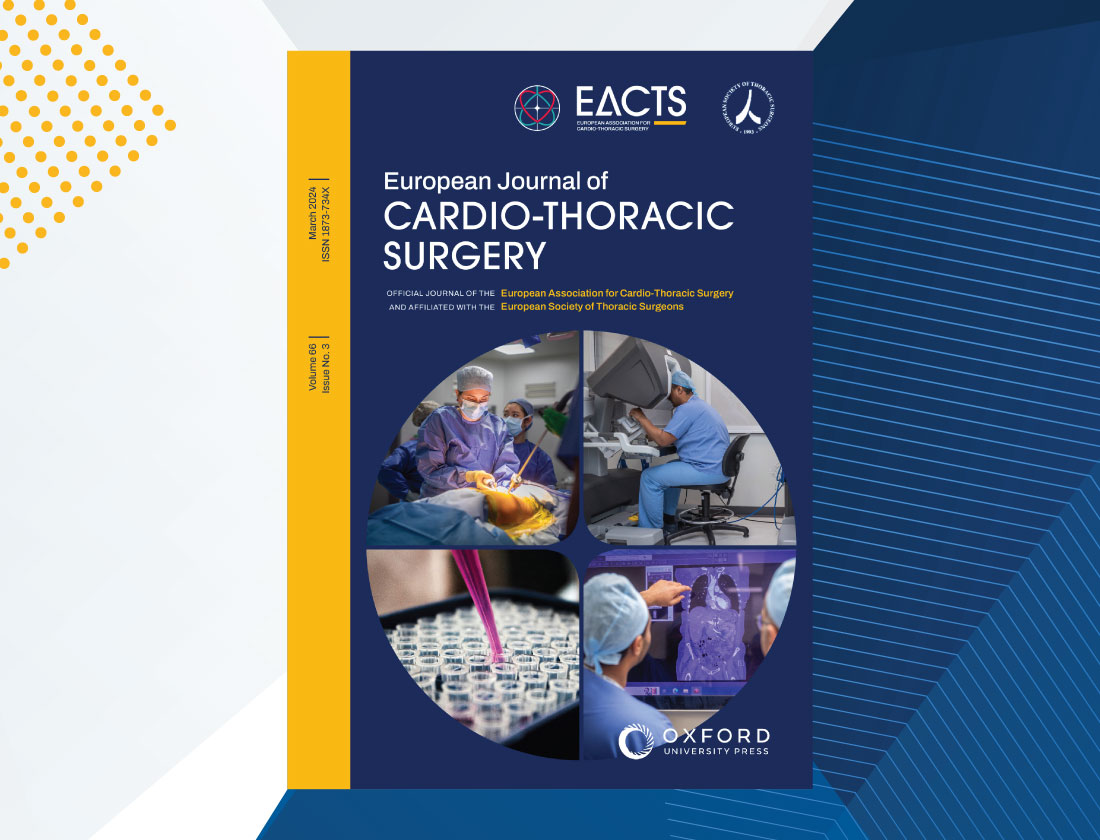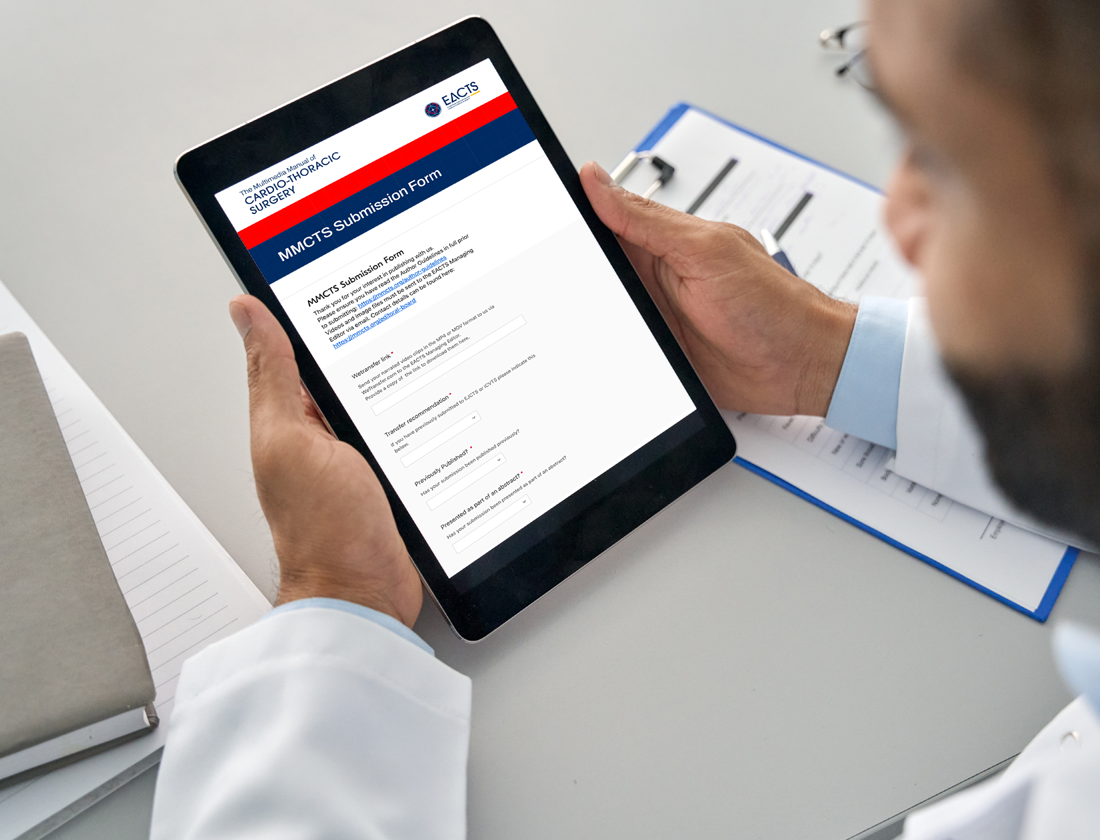Tutorial
Minimally invasive transaortic transcatheter aortic valve implantation of the CoreValve prosthesis: the direct aortic approach through a ministernotomy
Transcatheter implantation of the CoreValve bioprosthesis (Medtronic, Minneapolis, MN, USA) can be performed surgically through a minimally invasive approach: using an upper-J ministernotomy to the 2nd or 3rd intercostal space, the ascending aorta is exposed at a convenient location. After placing two purse-string sutures on the ascending aorta at least 7 cm above the aortic valve annulus, the CoreValve delivery system is advanced under fluoroscopy to the optimal position and the valve is deployed. Because of the short distance between the access point and the aortic annulus, positioning of the valve can be done more accurately in comparison with the transfemoral approach. We report a brief description of this surgical technique, its indications and limitations and the short-term results of our first series.
An increasing number of high-risk patients who present with severe aortic valve stenosis, unsuitable for surgical aortic valve replacement, may also have challenging anatomy or a lack of peripheral arterial accesses that makes a transfemoral transcatheter aortic valve implantation (TAVI) procedure too risky or not feasible. With relatively few contraindications, it is possible to use the ascending aorta as access for transcatheter aortic valve implantation. The recently developed transaortic approach technique (trans aortic TAVI [TAo TAVI]) for aortic valve implantation has been reported in few series performed in specialized centers with encouraging results . Two different techniques for accessing the ascending aorta have been initially described: an upper-J ministernotomy (Bapat et al.) and a right anterior thoracotomy (Bruschi et al.). Both techniques have been proved to be safe and feasible in small patient groups. We consider the transaortic approach very early in our decision-making process when screening possible candidates for TAVI. In our series, we opted for an upper-J ministernotomy to expose the ascending aorta because of its familiarity to the surgeons and reproducibility.
Patient's positioning allows exposure of the anterior chest and the groins. A pigtail catheter is advanced through the femoral artery until the non-coronary leaflet of the aortic valve and is left in place to perform aortographies during the procedure. A temporary pacemaker is inserted via the femoral vein and positioned in the coronary sinus to allow rapid pacing during deployment of the valve. The surgeon and the cardiologist are positioned at the right side of the table, as well as the scrub nurse. An upper-J ministernotomy is performed using different types of oscillating saws, depending on whether the case is a first procedure or a redo.

1 - Upper ministernotomy in first surgery and redo cases (0:00)
Often, the brachiocephalic vein is large or has adhesions, usually in redo patients and then a very careful dissection has to be done. Sometimes, it has to be encircled with two elastic tapes and is then gently retracted cranially to make exposure of the ascending aorta easier.

2 - Dissecting and isolating the brachiocephalic vein (1:02)
The surgeon inspects the ascending aorta and places a forceps on the supposed cannulation site. With the use of fluoroscopy, a graduated pigtail catheter is visualized and the distance between the cannulation site and annulus of the aortic valve can be assessed.

3 - Assessing the distance from the cannulation site to the aortic annulus (1:22)
Two 4–0 Prolene (Ethicon Inc.) purse-string sutures are placed at the selected cannulation site: the inner one without and the external one with reinforcement pledgets. Particular care is taken to maintain position on the outer curvature of the aorta, to allow a more perpendicular trajectory to the aortic valve annulus.

4 - Making of the purse strings (1:40)
The aorta is then punctured under fluoroscopy and a wire is advanced through the aorta, making sure that no resistance is encountered during this maneuver. A 6-Fr sheath is prepared and, when required, reduced to a length of 2 cm to maneuver the multipurpose catheter while crossing the aortic valve. The sheath is loaded on the dilator. The surgeon advances the sheath and ensures that the aortic wall is passed by the sheath.

5 - Positioning the multipurpose sheath (2:04)
A multipurpose catheter is then inserted in the 6-Fr sheath and advanced until ∼3 cm above the aortic valve annulus. The valve is crossed with a straight, preferable non-hydrophilic, wire, followed by another pigtail. A super-stiff or extra-stiff wire is then positioned in the left ventricle with the stiff curved part in the apex of the left ventricle.

6 - Crossing the valve (2:50)
While firmly holding the stiff wire in position, the sheath and the multipurpose catheter are retreated.

7 - Introduction of the delivery system (3:17)
A custom-made, 1-cm stop ring is constructed using a chest drainage tube and is mounted on the 18-Fr sheath of the delivery system (Gore, DrySeal) ±2 cm from its tip. This stop ring prevents the sheath from moving too deep in the aorta towards the aortic valve, thus leaving enough space for maneuvering the delivery system. The 18-Fr sheath is advanced over the stiff wire and through the aorta until the stop ring and held firmly in the position.

8 - Example of a predilatation of the valve (3:51)
In case of small leakage around the cannulation site, the purse strings may be tightened. If necessary, predilatation of the valve under rapid pacing can be performed at this stage.

9 - Positioning and deploying of the valve (4:07)
The delivery system is inserted over the stiff wire and advanced through the aortic valve under fluoroscopy, trying to approach it with an angle of 90°. In case, the angle is <90°, for example in particularly short or highly angulated aortas the surgeon can try to manipulate the aorta or the sheath in the desired direction in order to obtain the right angle. In redo cases, this is usually not possible due to adhesions.
The valve is then deployed under fluoroscopy using supravalvular injections to assess the progression of the deployment and eventually to adjust the positioning (Video 9). A supravalvular injection is also made 10 min after deployment to assess the result. While waiting pressure measurements can be taken to assess intraventricular and aortic pressures. Afterwards, the sheath can be withdrawn with tightening of the purse strings. Rapid pacing in this phase can be useful to decrease the arterial pressure, particularly useful in the presence of a fragile aorta. Chest closure is performed in a classical fashion with steel wires.
Outcome
Statistical analysis was performed using the SPSS software (SPSS, Inc.). Data collection was made according to the valve academy research consortium (VARC) standardized endpoint definitions . The overall results of the first 27 cases performed at our institution are reported in Table 1. Device success was achieved in 92.6% of the patients. Two patients received a second valve due to aortic regurgitation more than moderate after the placing of the first valve. The observed operative mortality was 4% and 30-day mortality was 11%.
Table 1: Results
|
Variables |
Absolute number (N = 27) |
|---|---|
|
Procedure time (min) |
113 ± 29 |
|
Medtronic CoreValve, n (%) |
20 (74) |
|
Edwards Sapien XT valve, n (%) |
7 (26) |
|
Valve size (mm), n (%) |
|
|
23 |
1 (4) |
|
26 |
9 (33) |
|
29 |
13 (48) |
|
31 |
4 (15) |
|
Device success (%) |
92.6 |
|
Combined safety endpoint (at 30 days), n (%) |
|
|
Intraoperative mortality |
1 (4) |
|
30-day mortality |
3 (11) |
|
Major stroke |
1 (4) |
|
Life-threatening bleeding |
1 (4) |
|
Renal insufficiency |
1 (4) |
|
Periprocedural myocardial infarction |
0 |
|
Major vascular complications |
0 |
|
Repeated procedures due to valve-related dysfunction |
0 |
|
Valve in previously implanted prosthesis |
4 (15) |
|
Re-exploration/cardiac tamponade |
2 (7) |
|
Postoperative pacemaker implantation |
2 (7) |
|
ICU stay (days) |
2.4 ± 2.5 |
|
Hospital stay (days) |
13.1 ± 10.8 |
Discussion
This initial single-centre experience showed the feasibility and safety of TAo TAVI in challenging patients lacking other suitable access routes for TAVI. Subclavian and transapical approaches are the most preferred alternatives to transfemoral TAVI, but they present several limitations. The first is limited by the size and quality of the subclavian artery relative to the size of the delivery system of the valve. The latter presents limitations due to the risks associated with the manipulation of the apex of the left ventricle in old and frail patients and issues on postoperative pain after thoracotomy and rib spreading. One of the theoretic advantages of the TAo TAVI through a ministernotomy is that the pleural space is left intact, preserving the respiratory function. A ministernotomy is believed to be less painful than a thoracotomy. Moreover, the distance between the point of insertion of the delivery system and the place of delivery is <10 cm, making it easier to correctly position the valve with fine adjustments. This, theoretically, may lead to a lower rate of pacemaker implantation, which mainly depends on the positioning of the valve. Too low an implantation may cause a compression of the bundle and the onset of a new left bundle branch block or a total atrio ventricular block, with a consequent increased need for pacemaker implantation. This has proved to be associated with worse long-term outcomes in several retrospective studies . The rate of permanent pacemaker implantation has been reported to be as high as 30% in series of patients who underwent TAVI, with a higher incidence in the series performed with CoreValve compared with the Sapien valves . The relatively low pacemaker implantation rate in our series (7%) may reflect a more accurate positioning of the valve, avoiding too deep an implantation and consequent compression of the conduction system. Improved control over the valve through a better tactile feedback and a reduced distance to the aortic annulus may also help preventing paravalvular leakage, which is also a strong predictor of long-term mortality in TAVI patients . The fact that TAo TAVI leaves the aortic arch untouched probably contributed to the relatively low incidence of neurological complications in our series (one major stroke, 4%), even if the numbers are still too small to be compared with other techniques .
As well as the other access routes, the transaortic approach also presents potential contraindications: the presence of a true porcelain aorta, a very short ascending aorta that does not permit a minimum of 7 cm distance from the cannulation site to the aortic valve annulus and severe chronic obstructive pulmonary disease making mechanical ventilation undesirable and if the patient is not willing to undergo general anesthesia. Moreover, the need for blood transfusion is increased with surgical TAVI when compared with the transfemoral approach. The fact that we implanted a second valve in 2 patients reflects the difficulty of sizing the aortic annulus in case of extreme irregular distribution of the calcifications and therefore choosing the proper valve size.
TAo TAVI is a valid alternative to transfermoral, transaxillary and transapical approach in high-risk patients lacking other access routes and can be performed with results comparable with those in the current literature. More multicenter studies collecting data prospectively following the VARC criteria are required to judge the long-term results in comparison with the current surgical technique.
- Bruschi G, de Marco F, Botta L, Cannata A, Oreglia J, Colombo P. Direct aortic access for transcatheter self-expanding aortic bioprosthetic valves implantation. Ann Thorac Surg 2012;94:497–503.
PubMed Abstract | Publisher Full Text - Bapat V, Attia R. Transaortic transcatheter aortic valve implantation: step-by-step guide. Semin Thorac Cardiovasc Surg 2012;24:206–11.
PubMed Abstract | Publisher Full Text - Leon MB, Piazza N, Nikolsky E, Blackstone EH, Cutlip DE, Kappetein AP, et al. Standardized endpoint definitions for transcatheter aortic valve implantation clinical trials: a consensus report from the Valve Academic Research Consortium. J Am Coll Cardiol 2011;57:253–69.
PubMed Abstract | Publisher Full Text - Petronio AS, De Carlo M, Bedogni F, Marzocchi A, Klugmann S, Maisano F, et al. Safety and efficacy of the subclavian approach for transcatheter aortic valve implantation with the CoreValve revalving system. Circ Cardiovasc Interv 2010;3:359–66.
PubMed Abstract | Publisher Full Text - Reynolds MR, Magnuson EA, Wang K, Lei Y, Vilain K, Walczak J, et al. PARTNER Trial Investigators. Cost-effectiveness of transcatheter aortic valve replacement compared with standard care among inoperable patients with severe aortic stenosis: results from the placement of aortic transcatheter valves (PARTNER) trial (Cohort B). Circulation 2012;125:1102–9.
PubMed Abstract | Publisher Full Text - Genereux P, Head SJ, Wood DA, Kodali SK, Williams MR, Paradis JM, et al. Transcatheter aortic valve implantation: 10-year anniversary part II: clinical implications. Eur Heart J 2012;33:2399–402.
PubMed Abstract | Publisher Full Text - Houthuizen P, Van Garsse LA, Poels TT, de Jaegere P, van der Boon RM, Swinkels BM, et al. Left bundle-branch block induced by transcatheter aortic valve implantation increases risk of death. Circulation 2012; 126:720–8.
PubMed Abstract | Publisher Full Text - Genereux P, Head SJ, Van Mieghem NM, Kodali S, Kirtane AJ, Xu K, et al. Clinical outcomes after transcatheter aortic valve replacement using valve academic research consortium definitions: a weighted meta-analysis of 3,519 patients from 16 studies. J Am Coll Cardiol 2012;59:2317–26.
PubMed Abstract | Publisher Full Text - Genereux P, Head SJ, Hahn R, Daneault B, Kodali S, Williams MR, et al. Paravalvular leak after transcatheter aortic valve replacement: The New Achilles' Heel? A comprehensive review of the literature. J Am Coll Cardiol 2013; 61:1125–36.
PubMed Abstract | Publisher Full Text - Miller DC, Blackstone EH, Mack MJ, Svensson LG, Kodali SK, Kapadia S, et al. Transcatheter (TAVR) versus surgical (AVR) aortic valve replacement: occurrence, hazard, risk factors, and consequences of neurologic events in the PARTNER trial. J Thorac Cardiovasc Surg 2012;143:832–843, e813.
PubMed Abstract | Publisher Full Text
None declared.
Authors
Hafid Amranea, Fabiano Portaa, Stuart Headb, Ad van Bovenc, and Arie Pieter Kappeteinb
Author Affiliations
aDepartment of Cardiothoracic Surgery, Medisch Centrum Leeuwarden, Leeuwarden, Netherlands
bDepartment of Cardiothoracic Surgery, Erasmus Medisch Centrum Rotterdam, Rotterdam, Netherlands
cDepartment of Interventional Cardiology, Medisch Centrum Leeuwarden, Leeuwarden, Netherlands
Corresponding Author
Hafid Amrane
Department of Cardiothoracic Surgery, Medisch Centrum Leeuwarden, Postbus 888, 8901 BR Leeuwarden, Netherlands
Phone: +31-058-2866636
Email: hafid.amrane@znb.nl
© The Author 2013. Published by MMCTS on behalf of the European Association for Cardio-Thoracic Surgery. All rights reserved.







